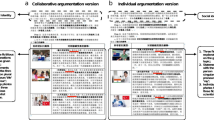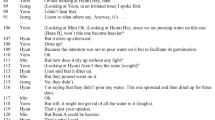Abstract
Changing practices in schools is a very complex endeavor. This paper is about new practices we prompted to foster collaboration and critical reasoning in science classrooms: the presentation of pictures representing different perspectives, small group synchronous argumentation, and moderation of synchronous argumentation. A CSCL tool helped in supporting synchronous argumentation through graphical representations of argumentative moves. We checked the viability of these practices in science classrooms. To do so, we investigated whether these practices led to conceptual learning, and undertook interactional analyses to study the behaviors of students and teachers. Thirty-two Grade 8 students participated in a series of activities on the day/night cycle. Learning was measured by the correctness of knowledge, the extent to which it was elaborated, the mental models that emerged from the explanations, the knowledge integration in explanations, and their simplicity. We showed that participants could learn the day/night cycle concept, as all measures of learning improved. For some students, it even led to conceptual change. However, the specific help provided by teachers during collective argumentation did not yield additional learning. The analysis of protocols of teacher-led collective argumentation indicated that although the teachers’ help was needed, some teachers had difficulties monitoring these synchronous discussions. We conclude that the next step of the design-research cycle should be devoted to (a) the development of new tools directed at helping teachers facilitate synchronous collective argumentation, and to (b) activities including teachers, designers, and researchers for elaborating new strategies to use these tools to improve the already positive learning outcomes from synchronous argumentation.


Similar content being viewed by others
References
Andriessen, J. E. B. & Schwarz, B. B. (2009). Argumentative Design. In N. Muller-Mirza, & A. -N. Perret-Clermont (Eds.). Argumentation and Education – Theoretical Foundations and Practices (pp. 145–174). Springer Verlag.
Arnseth, H. C., & Säljö, R. (2007). Making sense of epistemic categories. Analysing students’ use of categories of progressive inquiry in computer mediated collaborative activities. Journal of Computer Assisted Learning, 23, 425–439.
Asterhan, C. S. C., & Schwarz, B. B. (2007). The effects of monological and dialogical argumentation on concept learning in evolutionary theory. The Journal of Educational Psychology, 99(3), 626–639.
Asterhan, C. S. C., & Schwarz, B. B. (2009). Argumentation and explanation in conceptual change: Indications from protocol analyses of peer-to-peer dialog. Cognitive Science, 33, 374–400.
Asterhan, C. S. C., & Schwarz, B. B. (2010). Online moderation of synchronous e-argumentation. The International Journal of Computer-Supported Collaborative Learning, 5(3), 259–282.
Barnett, M., Yamagata-Lynch, L., Keating, T., Barab, S. A., & Hay, K. E. (2005). Using virtual reality computer models to support students understanding of astronomical concepts. Journal of Computers in Mathematics and Science Teaching, 24, 333–356.
Baxter, J. (1989). Children’s understanding of familiar astronomical events. International Journal of Science Education, 11, 502–513.
Chinn, C. A., & Brewer, W. F. (1998). An empirical test of a taxonomy of responses to anomalous data in science. Journal of Research in Science Teaching, 35(6), 623–654.
Collins, H., & Pinch, T. (1994). The Golem: What everyone should know about science. New York: Cambridge University Press.
Collins, A., Joseph, D., & Bielaczyc, K. (2004). Design research: Theoretical and methodological issues. Journal of the Learning Sciences, 13, 15–42.
Driver, R., Newton, P., & Osborne, J. (2000). Establishing the norms of scientific argumentation in classrooms. Science Education, 84, 287–312.
Dunbar, K. (1995). How scientists really reason: Scientific reasoning in real-world laboratories. In R. J. Sternberg & J. E. Davidson (Eds.), The nature of insight (pp. 3265–395). Cambridge: MIT.
Engeström, Y. (1987). Learning by expanding. In Y. Engeström, R. Mettinen, & R. L. Punamäki (Eds.), Aspects of activity theory. Cambridge: Cambridge University Press.
Erduran, S., Osborne, J. F., & Simon, S. (2004). Enhancing the quality of argument in school science. Journal of Research in Science Teaching, 41(10), 994–1020.
Hakkarainen, K., Paavola, S., & Lipponen, L. (2004). From communities of practice to innovative knowledge communities. Line: Lifelong Learning in Europe, 9(2), 74–83.
Hakkarainen, K. (2010). Learning communities in the classroom. In K. Littleton, C. Wood, & J. K. Staarman (Eds.), International Handbook of Psychology in Education (pp. 177–225). Emerald.
Howe, C. J., Tolmie, A., Duchak-Tanner, V., & Rattray, C. (2000). Hypothesis testing in science: group consensus and the acquisition of conceptual and procedural knowledge. Learning and Instruction, 10, 361–391.
Kikas, E. (2004). Teachers’ conceptions and misconceptions concerning three natural phenomena. Journal of Research in Science Teaching, 5, 432–448.
Latour, B., & Woolgar, S. (1979). Laboratory life: The social construction of scientific facts. Princeton: Princeton University Press.
Linn, M., Davies, E. A., & Bell, P. (2004). Inquiry and technology. In M. C. Linn, E. A. Davis, & P. Bell (Eds.), Internet environments for science education. Cambridge: Cambridge University Press.
Longino, H. (1994). The fate of knowledge in social theories of science. In F. F. Schmitt (Ed.), Socializing epistemology: The social dimensions of knowledge (pp. 135–158). Lanham: Rowan and Littlefield.
McAlister, S., Ravenscroft, A., & Scanlon, E. (2004). Combining interaction and context design to support collaborative argumentation using a tool for synchronous CMC. Journal of Computer Assisted Learning, 20(3), 194–204.
Mortimer, E. F., & Scott, P. (2003). Meaning making in secondary science classrooms. Buckingham: Open University Press.
Nussbaum, J. (1985). The Earth as a cosmic body. In E. Guesne, A. Tiberghien, & R. Driver (Eds.), Children’s ideas in science. Milton Keynes: Open University Press.
Osborne, J., Erduran, S., & Simon, S. (2004). Enhancing the quality of argument in school science. Journal of Research in Science Teaching, 41(10), 994–1020.
Piaget, J. (1977). The grasp of consciousness: Action and concept in the young child. London: Routledge.
Rasmussen, I., & Ludvigsen, S. (2009). The Hedgehog and the fox: a discussion of the approaches to the analysis of ICT Reforms in teacher education of Larry Cuban and Yrjö Engeström. Mind, Culture, and Activity, 16(1), 83–104.
Rasmussen, I. & Ludvigsen, S. (2010). Learning with computer tools and environments: A socio-cultural perspective. In K. Littleton, C. Wood, & J. K. Staarman (Eds.), International handbook of psychology in education (pp. 399–434). Emerald.
Reiser, B. J., Tabak, I., Sandoval, W. A., Smith, B., Steinmuller, F., & Leone, T. J. (2001). BGuILE: Stategic and conceptual scaffolds for scientific inquiry in biology classrooms. In S. M. Carver, & D. Klahr (Eds.), Cognition and instruction: Twenty five years of progress. Mahwah, NJ: Erlbaum.
Rummel, N., & Spada, H. (2005). Learning to collaborate: an instructional approach to promoting collaborative problem solving in computer-mediated settings. Journal of the Learning Sciences, 14, 201–241.
Rummel, N., Spada, H., & Hauser, S. (2009). Learning to collaborate while being scripted or by observing a model. International Journal of Computer-Supported Collaborative Learning, 4, 69–92.
Sandoval, W. A. (2003). Conceptual and epistemic aspects of students’ scientific explanations. Journal of the Learning Sciences, 12(1), 5–51.
Sandoval, W. A., & Reiser, B. J. (2004). Explanation-driven inquiry: integrating conceptual and epistemic scaffolds for scientific inquiry. Science Education, 88, 345–372.
Schoultz, J., Säljö, R., & Wyndhamn, J. (2001). Heavenly talk: Discourse, artifacts, and children’s understanding of elementary astronomy. Human Development, 44, 103–118.
Schur, Y. (1998). Thinking journey to the moon. Jerusalem: Ma’alot. in Hebrew.
Schur, Y. & Galili, I. (2008). A thinking journey: A new mode of teaching science. International Journal of Science and Mathematics Education. On line: http://www.springerlink.com/content/u8uhj156546p7072/.
Schur, Y. & Kozulin, A. (2008). Cognitive aspects of science problem solving: two mediated learning experience based programs. Journal of Cognitive Education and Psychology, 7(2).
Schur, Y., Skuy, M., Zietsman, A., & Fridjhon, P. (2002). A Thinking journey based on constructivism and mediated learning experience as a vehicle for teaching science to low functioning students and enhancing their cognitive skills. School Psychology International, 23(1), 36–67.
Schwarz, B. B. (2008). Escalate: The white book. www.escalate.org.il.
Schwarz, B. B. & Asterhan, C. S. C. (2010). E-moderation of synchronous discussions in educational settings: A nascent practice. To appear in the Journal of the Learning Sciences.
Schwarz, B. B., & De Groot, R. (2007). Argumentation in a changing world. International Journal of Computer-Supported Collaborative Learning, 2(2–3), 297–313.
Schwarz, B. B. & De Groot, R. (2010). Breakdowns between teachers, educators and designers in elaborating new technologies as precursors of change in education to dialogic thinking. In S. Ludvigsen, A. Lund, & R. Säljö (Eds.), Learning Across Sites: New tools, infrastructures and practices (pp. 261–277). New Perspectives on Learning and Instruction Series. Routledge.
Schwarz, B. B., & Glassner, A. (2007). The role of floor control and of ontology in argumentative activities with discussion-based tools. International Journal of Computer Supported Collaborative Learning, 3(4), 449–478.
Schwarz, B. B., Asterhan, C. S. C. & Gil, J. (2009). Human guidance of synchronous e-discussions: The effects of different moderation scripts on peer argumentation. Proceedings of the Computer-Supported Collaborative Learning Conference. University of Rhodes, Greece.
Scott, P., Ametller, J., Mortimer, E., & Emberton, J. ((2010). Teaching and Learning disciplinary knowledge: developing the dialogic space for an answer when there isn’t even a question. In C. Howe & K. Littleton (Eds.), Educational dialogues: Understanding and promoting productive interaction (pp. 289–303). Routledge.
Stegmann, K., Weinberger, A., & Fischer, F. (2007). Facilitating argumentative knowledge construction with computer-supported collaboration scripts. International Journal of Computer-Supported Collaborative Learning, 2, 421–447.
Suthers, D. D. (2003). Representational guidance for collaborative inquiry. In J. Andriessen, M. Baker, & D. Suthers (Eds.), Arguing to learn: Confronting cognitions in computer-supported collaborative learning environments (pp. 27–46). Dordrecht: Kluwer Academic.
Trumper, R. (2001). A cross age study of senior high school students’ conceptions of basic astronomy concepts. Research in Science & Technological Education, 19, 97–107.
van Eemeren, F. H., Grootendorst, R., Henkenmans, F. S., Blair, J. A., Johnson, R. H., Krabb, E. C., et al. (1996). Fundamentals of argumentation theory: A handbook of historical background and contemporary developments. Hillsdale: Lawrence Erlbaum Associates, Inc.
Vosniadou, S. A., & Brewer, W. F. (1994). Mental models of the day/night cycle. Cognitive Science, 18, 123–182.
Vosniadou, S., Skopeliti, I., & Ikospentaki, K. (2004). Modes of knowing and ways of reasoning in elementary astronomy. Cognitive Development, 19, 203–222.
Vygotsky, L. S. (1987). Thinking and speech. N. Minick (Ed. and translator). New York: Plenum.
Walton, D. (2006). Fundamentals of critical argumentation: Critical reasoning and argumentation. New York: Cambridge University Press.
Weinberger, A., Ertl, B., Fischer, F., & Mandl, H. (2005). Epistemic and social scripts in computer supported collaborative learning. Instructional Science, 33, 1–30.
Yair, Y., Schur, Y., & Mintz, R. (2003). A Thinking Journey to the solar system using scientific visualization technologies. Journal of Science Education and Technology, 12(1), 43–49.
Acknowledgement
The research reported here was carried out as a part of the ESCALATE Project (020790 SAS6) supported by the 6th Framework Program of the European Community. We are grateful to Reuma De Groot and Raul Drachman for coordinating all the project efforts.
Author information
Authors and Affiliations
Corresponding author
Rights and permissions
About this article
Cite this article
Schwarz, B.B., Schur, Y., Pensso, H. et al. Perspective taking and synchronous argumentation for learning the day/night cycle. Computer Supported Learning 6, 113–138 (2011). https://doi.org/10.1007/s11412-010-9100-x
Received:
Accepted:
Published:
Issue Date:
DOI: https://doi.org/10.1007/s11412-010-9100-x




